Text
Hellreaver
A Barbarian Subclass
Devils and their ilk can go only so far before their actions demand a response. At some point, a devil will destroy enough lives that someone has to take a stand. That someone is often a hellreaver - a warrior whose outrage at the actions of the fiends and their ability to corrupt and seduce without consequence fuels an array of combat abilities. These potent options make these warriors tremendously effective combatants of the baatezu.
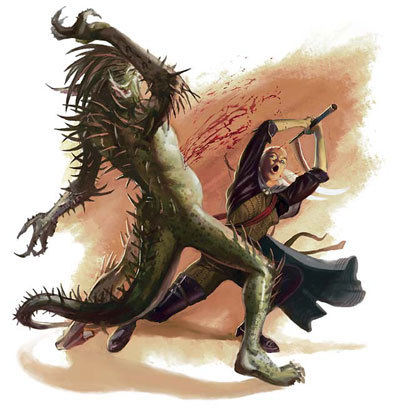
Holy Fury
Starting when you choose this path at 3rd level, whenever you rage, you gain a pool of holy fury points equal to your proficiency bonus plus your Constitution modifier. These points are lost when your rage ends.
Furious Strike
At 3rd level, when you miss with an attack, you may spend 1 holy fury point to re-roll the attack with advantage.
Divine Shield
Also at 3rd level, when you are hit with an attack, you may spend 1 holy fury point as a reaction. When you do, you get a bonus to AC equal to your proficiency bonus until your next turn, including against the triggering attack.
Divine Succor
At 6th level, whenever you spend holy fury, you also get that many d8 in temporary hit points. You may also spend any number of holy fury points as a bonus action to activate this effect.
Call to Judgment
At 10th level, when a creature within 60 ft tries to use any method of extradimensional movement, including teleportation or travel to a different plane of existence, you may spend 3 holy fury points and your reaction. If you do, until your rage ends, no creature within 60 ft of you can use any method of extradimensional movement, including the triggering creature.
Divine Retribution
Beginning at 14th level, before you make an attack roll, you may spend 4 holy fury points to have the attack deal an additional 4d8 radiant damage. This radiant damage is doubled if the target is a fiend. The creature is disintegrated if the attack leaves it with 0 hit points. A fiend disintegrated this way does not reform on their home plane, but is instead destroyed forever.
Once you use this feature, you can’t use it again until you finish a long rest.
0 notes
Text
Planar Shepherd
A subclass for druids
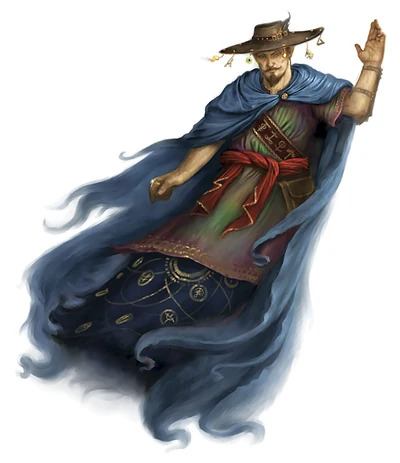
Bonus Cantrip
When you choose this circle at 2nd level, you learn one additional druid cantrip of your choice. This cantrip doesn’t count against the number of druid cantrips you know.
Planar Initiate
At 2nd level, you are admitted into your choice of the Greensingers, a chaotic Eldeen Reaches sect with close ties to the fey, or Nightbringers, a new offshoot of the Children of Winter. The training you receive as an initiate both gives you proficiency in a skill and infuses you with the ability to cast certain spells. At 3rd, 5th, 7th, and 9th level you gain access to the faction’s circle spells. Consult the associated list of spells. If you are already proficient with the skill, you instead gain proficiency with one of the following skills: Arcana, Animal Handling, Insight, Medicine, Nature, Perception, Religion, and Survival
Once you gain access to a circle spell, you always have it prepared, and it doesn't count against the number of spells you can prepare each day. If you gain access to a spell that doesn't appear on the druid spell list, the spell is nonetheless a druid spell for you.
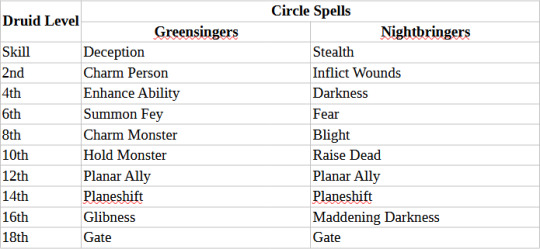
Planar Attunement
At 6th level, you gain a deeper connection to the planes. As an action, you can expend two uses of your Wild Shape feature to transform into one of the following forms, based on your level:

Planar Bubble
Starting at 10th level, you can create as an action an area that emulates the Feywild (if you’re a Greensinger) or the Shadowfell (if you’re a Nightbringer). As an action, this area appears as a 20-foot-radius sphere centered on a point within 150 ft of you. It lasts for 1 minute or until you spend an action to dismiss it, as has the following effects:
Greensinger: If you’re a greensinger, the area of Feywild counts as difficult terrain. The area is filled with bright light, with another 5 ft of dim light on the area around the sphere. Any creature other than you who ends their turn within the area must make a Charisma saving throw or be charmed by you.
Nightbringer: If you’re a nightbringer, the area of Shadowfell counts as difficult terrain. Any nonmagical light in the area is surpressed. Any creature other than you who ends their turn within the area must make a Wisdom saving throw or be frightened of you, as by the fear spell.
Planar Self
At 14th level, you gain one of the following abilities, based on your faction:
Greensinger: You are resistant to radiant damage and immune to necrotic and poison damage.
Nightbringer: You are resistant to cold and fire damage and immune to poison damage.
0 notes
Text
Zerth Cenobite
A subclass for monks
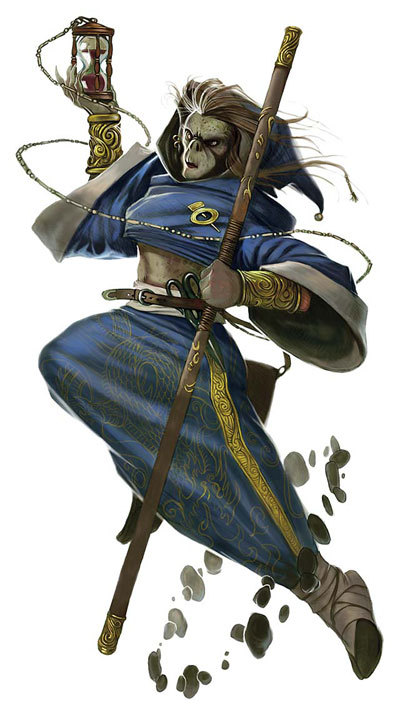
The core of a zerth cenobite's studies involve strict meditation on the nature of time and the body's movements through it, culminating in a martial art known as zerthin. Zerthin teaches that though the passage of time allows events to become chaotic and uncontrolled, a disciplined mind can view the time stream as just one more dimension of space. Practitioners of zerthin claim to be able to peer into the future, enhancing their martial expertise to unmatched heights.
Spellcasting
When you reach 3rd level, your training in zerthin has given you the ability to cast spells.
Cantrips
You learn two cantrips of your choice from the cleric spell list. You learn an additional cleric cantrip of your choice at 10th level.
Spell Slots
The Zerth Cenobite Spellcasting table shows how many spell slots you have to cast your cleric spells of 1st level and higher. To cast one of these spells, you must expend a slot of the spell's level or higher. You regain all expended spell slots when you finish a long rest.
For example, if you know the 1st-level spell Cure Wounds and have a 1st-level and a 2nd-level spell slot available, you can cast Cure Wounds using either slot.
Spells Known of 1st Level and Higher
You know three 1st-level cleric spells of your choice.
The Spells Known column of the Zerth Cenobite Spellcasting table shows when you learn more cleric spells of 1st level or higher. For instance, when you reach 7th level in this class, you can learn one new spell of 1st or 2nd level.
Whenever you gain a level in this class, you can replace one of the cleric spells you know with another spell of your choice from the cleric spell list.
Spellcasting Ability
Wisdom is your spellcasting ability for your cleric spells, since you learn your spells through study and memorization. You use your Wisdom whenever a spell refers to your spellcasting ability. In addition, you use your Wisdom modifier when setting the saving throw DC for a cleric spell you cast and when making an attack roll with one.
Spell save DC = 8 + your proficiency bonus + your Wisdom modifier
Spell attack modifier = your proficiency bonus + your Wisdom modifier
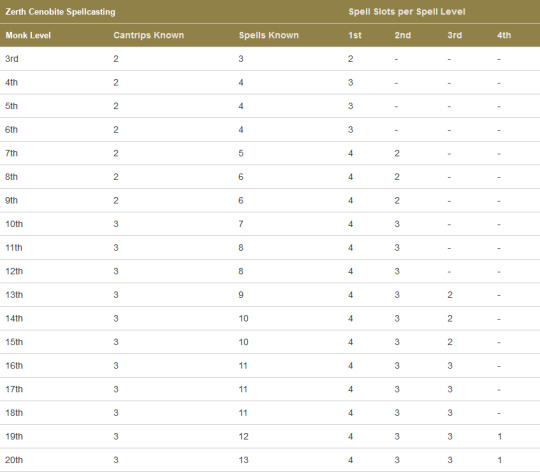
Temporal Distillation
At 3rd level, your mastery of your ki allows you to enter another time frame, moving much more quickly than other creatures around you. When you dash, you may take an additional bonus action that turn.
Once you use this feature, you can't use it again until you finish a short or long rest.
Backslide
Starting at 6th level, your mental mastery of temporal flow grows sufficiently large that you can gaze a few instants into the past. Whenever you make an attack roll, an ability check, or a saving throw and fail, you can expend a reaction to reroll it and take the second result.
Once you use this feature, you can't use it again until you finish a short or long rest.
Timeless Step
At 11th level, you can spend 1 or more ki points as an action to step out of the time stream.
In effect, you seem to disappear, then reappear the appropriate number of rounds later. You reappear in the same orientation and condition as before. For you, no time has passed at all.
If the space from which you departed is occupied upon your return to the time stream, you appear in the closest unoccupied space, still in your original orientation. Determine the closest space randomly if necessary.
Timeless Strike
Also at 11th level, when you hit another creature with a melee weapon attack, you can spend 2 ki point to attempt a timeless strike. The target must succeed on a Wisdom saving throw or be forcibly stepped out of the time stream for 1d4 rounds, similarly to Timeless Step.
Precognitive Surge
Starting at 17th level, you can spend 9 ki points to cast either foresight or time stop as an action.
Once you use this feature, you can't use it again until you finish a short or long rest.
0 notes
Text
Flayerspawn Psychic
A subclass for Sorcerer
Willing to sacrifice her life, appearance, and even her sanity, the flayerspawn psychic walks a dangerous road, growing in psionic power as she slowly embraces her secret mind flayer heritage. By every race that is aware of their existence mind flayers are considered to be the most powerful and dangerous psionic creatures. The temptation to take on some of an illithid's power is thus extremely attractive to those who seek power above all else.
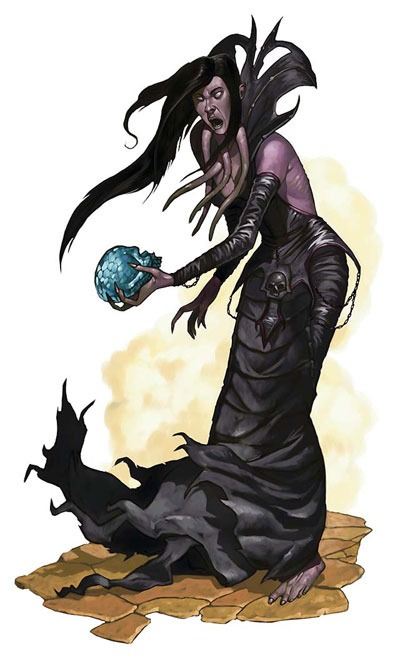
Mind Blast
Starting at 1st level, you can magically emit psychic energy. As an action, each creature in a 15-foot cone must succeed on an Intelligence saving throw or take 1d10 psychic damage and be stunned for 4 rounds. A creature can repeat the saving throw at the end of each of its turns, ending the effect on itself on a success. The DC of this saving throw is equal to your spell save DC. The damage increases by 1d10 when you reach 5th level (2d10), 11th level (3d10), and 17th level (4d10).
Once you use this feature, you can't do so again until you finish a long rest, unless you spend 2 sorcery points to use it again.
Psychic Compulsion
Beginning at 6th level, the DC of enchantment spells you cast is increased by +2.
Illithid Tentacles
Beginning at 14th level, you grow tentacles that you can use to make unarmed strikes. You can use these tentacles to hold small objects, including arcane foci, and to perform the somatic components of spells. In addition, as long as you hold nothing in your tentacles, you can use them as a whip; dealing 1d4 slashing damage and possessing the finesse and reach properties.
Extract Brain
Beginning at 18th level, you can, as an action, make a melee spell attack with your tentacle. If it hits and the target is your size or smaller, they must make a Strength saving throw or be grappled by you. The DC of this saving throw is equal to your spell save DC. As long as you have grappled a creature this way, you cannot grapple another creature this way or attack with your tentacle.
During your turn, if you have been grappling a creature with your tentacles since the beginning of your turn, you may, as an action, attempt to extract the creature’s brain. The creature makes an Intelligence saving throw. If they fail, they take 10d10 piercing damage. If this damage reduces the target to 0 hit points, you kill the target by extracting and devouring its brain.
Once you attempt to extract a creature’s brain, you can't do so again until you finish a long rest, unless you spend 4 sorcery points to use it again.
0 notes
Text
Dragon Samurai
A subclass for Fighters
Dragon samurai are dedicated warriors, members of a special, self-selected class who revere dragonkind and emulate dragons’ ferocious martial abilities to the point of taking on some draconic traits. Unlike noble samurai, who are born to their role and into a system of allegiance, dragon samurai are made, not born. Each dragon samurai is bound to a single dragon clan.
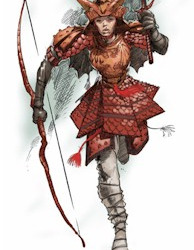
Spellcasting
When you reach 3rd level, you augment your martial prowess with the ability to cast spells.
Cantrips
You learn two cantrips of your choice from the sorcerer spell list. You learn an additional sorcerer cantrip of your choice at 10th level.
Spell Slots
The Dragon Samurai Spellcasting table shows how many spell slots you have to cast your sorcerer spells of 1st level and higher. To cast one of these spells, you must expend a slot of the spell's level or higher. You regain all expended spell slots when you finish a long rest.
For example, if you know the 1st-level spell Shield and have a 1st-level and a 2nd-level spell slot available, you can cast Shield using either slot.
Spells Known of 1st Level and Higher
You know three 1st-level sorcerer spells of your choice.
The Spells Known column of the Dragon Samurai Spellcasting table shows when you learn more sorcerer spells of 1st level or higher. Each of these spells must be of a level for which you have spell slots. For instance, when you reach 7th level in this class, you can learn one new spell of 1st or 2nd level.
Whenever you gain a level in this class, you can replace one of the sorcerer spells you know with another spell of your choice from the sorcerer spell list. The new spell must be of a level for which you have spell slots.
Spellcasting Ability
Charisma is your spellcasting ability for your sorcerer spells, since you learn your spells through study and memorization. You use your Charisma whenever a spell refers to your spellcasting ability. In addition, you use your Charisma modifier when setting the saving throw DC for a dragon samurai spell you cast and when making an attack roll with one.
Spell save DC = 8 + your proficiency bonus + your Charisma modifier
Spell attack modifier = your proficiency bonus + your Charisma modifier

Dragon Clan
At 1st level, you choose which type of dragon you dragon clan’s patron is. The damage type associated with each dragon is used by features you gain later.
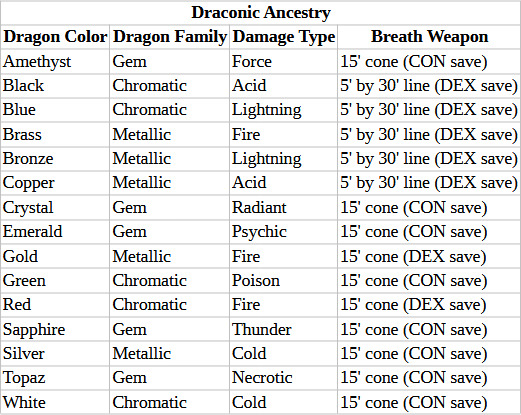
You can speak, read, and write Draconic. Additionally, whenever you make a Charisma check when interacting with dragons, your proficiency bonus is doubled if it applies to the check.
Draconic Breath
Beginning at 7th level, when you take the Attack action, you can replace one of your attacks with an exhalation of a magical energy that deals damage in an area according to your clan. When you use your breath weapon, all creatures in the area must make a saving throw, the type of which is determined by your ancestry. The DC of this saving throw is equal to your spell save DC. A creature takes a number of d10 of damage equal to your proficiency bonus on a failed save, and half as much damage on a successful one.
Draconic Resilience
At 10th level, you gain resistance to the damage type associated with your clan.
Dragon Rider
At 15th level, you learn how to summon a dragon spirit, traditionally used as a mount. As an action, you can magically summon a spirit dragon. It appears in an unoccupied space of your choice within 60 feet of you.
The spirit dragon is friendly to you and your companions, and it obeys your commands. It form uses the Draconic Spirit stat block, as per the Summon Draconic Spirit spell cast with a 5th level spell slot.
In combat, the spirit dragon shares your initiative count, but it takes its turn immediately after yours. It can move and use its reaction on its own, but the only action it takes on its turn is the Dodge action, unless you take a bonus action on your turn to command it to take another action. That action can be one in its stat block or some other action. If you are incapacitated, the spirit dragon can take any action of its choice, not just Dodge.
The spirit dragon remains until it is reduced to 0 hit points, until you use this feature to summon the spirit dragon again, or until you die. Anything the spirit dragon was wearing or carrying is left behind when the spirit dragon vanishes.
Once you summon the spirit dragon, you can’t do so again until you finish a short or long rest.
Draconic Might
Starting at 18th level, while you are riding your draconic spirit, you may, as an action, render yourself and the spirit immune to all damage for one minute. This effect ends if you become incapacitated, unconscious, or you die. Once you use this feature, you can’t do so again until you finish a long rest.
0 notes
Text
Acolyte of the Skin
A Warlock Subclass
The temptation of power drives some people to extreme lengths, regardless of the consequences. Replacing your own skin with that of a living demon is a goal that most couldn’t even conceive of, let alone consider. But this ghastly fate is exactly what some spellcasters seek in their desperate quest.
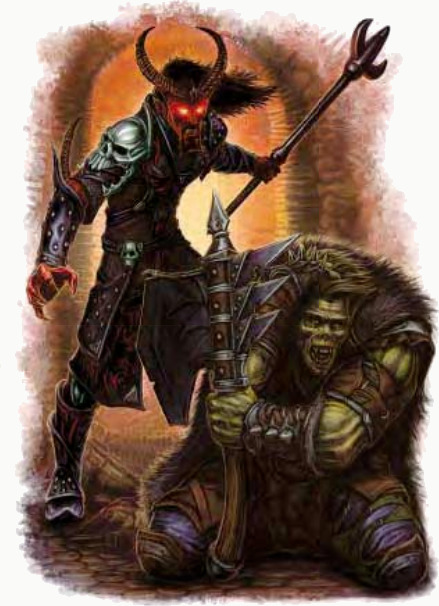
Expanded Spell List
The following spells are added to the warlock spell list for you.
1st: Absorb Elements, Bane
2nd: Barkskin, Flame Blade
3rd: Fly, Vampiric Touch
4th: Fire Shield, Stoneskin
5th: Anti-life Shell, Contact Other Plane
Ritual of Bonding
Starting at 1st level, you undergo a ritual to peel away your own skin and replace it with a fiend. This gives the following benefits:
Fiendish Skin. While you are not wearing any armor, your armor class equals 10 + your Dexterity modifier + your Charisma modifier. You can use a shield and still gain this benefit. In addition, your fiendish skin is treated as an arcane focus for Warlock spells you cast.
Fiendish Claws. Each of your hands transforms into a claw, which you can use as a weapon if it’s empty. It deals 1d6 slashing damage on a hit. When you attack with a claw, you can use your Charisma modifier, instead of Strength, for the attack and damage rolls. Your claws count as magical for the purpose of overcoming resistance and immunity to nonmagical attacks and damage.
Bonded Adaptation
Starting at 6th level, your ability to use your bonded fiend increases.
Skin Adaptation. While you are not wearing any armor, you gain a flying speed equal to your walking speed. You can use a shield and still gain this benefit.
Claw Adaptation. Whenever you hit a creature with a claw attack, they must make a Constitution saving throw against your spell save DC. On a failure, they take 1d6 poison damage and are poisoned for 1 round. On a success, they take half as much damage and are not poisoned.
Glare of the Pit
Starting at 10th level, you can cast Eldritch Blast with your gaze alone, casting it without verbal or somatic components.
In addition, you may cast Eldritch Blast as a bonus action. Once you use this feature, you must finish a short or long rest before you can use it again.
Fiend Symbiosis
Starting at 14th level, your ability to use your bonded fiend reaches its full power.
Skin Symbiosis. While you are not wearing any armor, you gain temporary hit points at the start of each round equal to your proficiency bonus plus your Charisma modifier for one round. You can use a shield and still gain this benefit.
Claw Symbiosis. The claw damage and additional damage from Claw Adaptation each improves to 1d8. As an action, you may make a single attack with your claw. If it hits, the target is affected as if by a contagion spell, with save DC equal to your spell save DC. Once you use this part of this feature, you must finish a short or long rest before you can use it again.
0 notes
Text
Illumine Soul
A Rogue Subclass
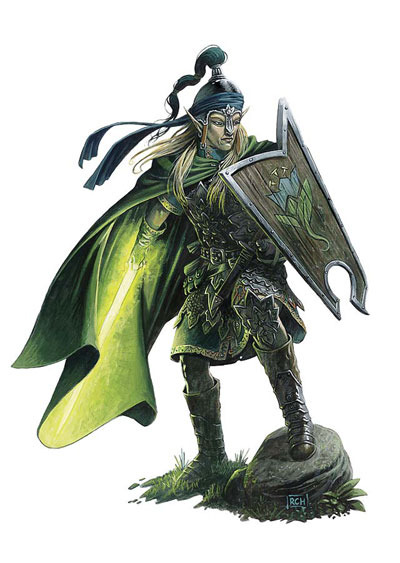
The illumine soul is a living conduit of positive energy. He is able to forge a blade of semisolid psychic energy and infuse it with the essence of the Positive Energy Plane to deal lethal strikes to undead opponents. As an illumine soul practices this unique talent, he learns to fill up his being with the power of the Positive Energy Plane, becoming a light in the darkness and turning undead away from his radiance.
Desirous of something more than raw psychic energy, an illumine soul learns to reach behind the sky and form a mental link with the Positive Energy Plane. He entwines this energy with that of his own psionic mastery to create a formidable weapon of brilliance that extinguishes all shadows.
Psionic Power
Starting at 3rd level, you harbor a wellspring of psionic energy within yourself. This energy is represented by your Psionic Energy dice, which are each a d6. You have a number of these dice equal to twice your proficiency bonus, and they fuel various psionic powers you have, which are detailed below.
Some of your powers expend the Psionic Energy die they use, as specified in a power's description, and you can't use a power if it requires you to use a die when your dice are all expended. You regain all your expended Psionic Energy dice when you finish a long rest. In addition, as a bonus action, you can regain one expended Psionic Energy die, but you can't do so again until you finish a short or long rest.
When you reach certain levels in this class, the size of your Psionic Energy dice increases: at 5th level (d8), 11th level (d10), and 17th level (d12).
The powers below use your Psionic Energy dice.
Positive Energy Ray. You project a ray of radiant energy. As a bonus action, you can force a creature within 30 ft to make a Dexterity saving throw against a DC equal to 8 + your proficiency bonus + your Dexterity modifier. If the save fails, you expend one Psionic Energy die, rolling it and dealing radiant damage to the target equal to the number rolled plus your Dexterity modifier, and the next attack roll made against this target before the end of your next turn has advantage. You expend the die only if the save fails.
Positive Energy Healing. You use your connection to the positive energy plane to heal yourself and others. As an action, you expend one Psionic Energy die, rolling it and restoring a number of hit points equal to the number rolled plus your rogue level. Choose any creatures within 30 feet of you, and divide those hit points among them.
Illumine Blade
Also at 3rd level, you can manifest your psionic power as a shimmering blade of positive energy. Whenever you take the Attack action, you can manifest an illumine blade from your free hand and make the attack with that blade. This magic blade is a simple melee weapon with the finesse and versatile properties. On a hit, it deals radiant damage equal to 1d6 plus the ability modifier you used for the attack roll, or 1d8 plus the ability modifier you used for the attack roll if the blade is held in two hands. The blade vanishes immediately after it hits or misses its target, and it leaves no mark on its target if it deals damage.
Death Ward
Starting at 9th level, you are protected from death. You are resistant to necrotic damage, and immune to disease and poison.
Positive Energy Flare
At 13th level, you can project an aura of radiant energy. As an action, you can expend three Psionic Energy dice to name each creature within 30 ft friend or foe. You and each friend is restored a number of hit points equal to the number rolled plus your rogue level. Each foe makes a Dexterity saving throw against a DC equal to 8 + your proficiency bonus + your Dexterity modifier. If the save fails, you deal radiant damage to the target equal to the number rolled plus your Dexterity modifier, and the next attack roll made against this target before the end of your next turn has advantage.
Brilliant Blade
Starting at 17th level, when you score a critical hit with your illumine blade, you gain one of the following benefits:
Bodyfeeder: You gain temporary hit points equal to the damage dealt for one minute.
Mindfeeder: You recover one of your expended Psionic Energy dice.
Soulbreaker: The target is cursed as if they had failed their saving throw against the bestow curse spell cast with a 9th level spell slot.
0 notes
Text
Psionic Subclasses
Psionics isn't a thing in 5e, but let's try to make these anyway.
Arguably Already Subclasses
Cerebremancer - A multiclassing prestige class, for wizard/psions. Has no class features and overlaps highly with the psion unearth arcana.
Illithid Slayer - A prestige class that hunts illithids. I'm thinking ranger conclave. It's very similar to monster slayer conclave.
Anarchic Initiate - A prestige class for wilders with chaotic surge. Very similar to wild magic sorcerers.
Ebon Saint - A prestige class for lurks. Extremely similar to gloom stalker rangers.
Complicated Subclasses
Fist of Zuoken - A multiclassing prestige class, for monk/psions. Has no class features.
Metamind - A psion prestige class centered on maximizing power points. Maybe a sorcerer subclass that gets bonus sorcery points?
Psion Uncarnate - A psion prestige class that becomes an incorporeal ghost. Really could be adapted to any caster class.
Pyrokineticist - A fiery prestige class for non-casters. Setting fires for its own sake brings to mind barbarians, but they already have storm herald. Might go for it anyway.
Thrallherd - A psionic class with an army of followers. It doesn't really fit in with 5e's systems. If I can majorly rework it, it's probably going to the bard.
Ectopic Adept - A prestige class for characters that really like the astral construct spell. A pet subclass for wizard makes sense to me.
New Subclasses, Uncomplicated
Flayerspawn Psychic - A prestige class for characters that want to be illithid like. An illithid bloodline for sorcerers sounds good.
Illumine Soul - A healer prestige class for soulknives. So, a healer subclass for rogues? Sounds funky.
Soulbow - A prestige class for soulknives about shooting mind arrows. A fighter subclass makes sense.
Storm Disciple - A prestige class for divine psychics who wield martial thunder. Paladin for sure.
Zerth Cenobite - A monk prestige class about time travel.
Elocater - A mobile prestige class for psychic warriors. Adapting it to rogues.
War Mind - A prestige class a lot like the eldritch knight, but with battlefield commander vibes.
1 note
·
View note
Text
Thaumaturgist
Or Planes Domain Cleric
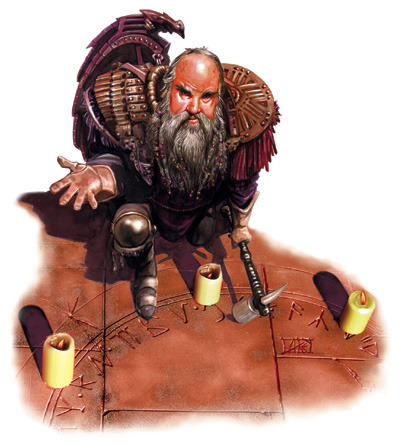
A thaumaturgist is keenly aware that his unparalleled conjurations are just tools in service of his overall philosophy or deity. Thus, thaumaturgists often undertake quests to advance a cause, using their abilities to conjure up a strike force of summoned and called creatures at a moment’s notice.
Planes Domain Spells
Cleric Level Spells
1st Unseen Servant
3rd Find Steed
5th Conjure Animals
7th Conjure Minor Elementals
9th Planar Binding
11th Planar Ally
13th Plane Shift
15th Demiplane
17th Gate
Planar Talent
When you choose this domain at 1st level, you gain proficiency in the Arcana skill. You also learn in your choice of two of the following skills: Abyssal, Celestial, Infernal, Primordial.
Astral Chains
Also starting at 1st level, you gain the Warlock’s Pact of the Chain feature. In addition, your Cleric level stacks with your Warlock level to meet the Warlock level prerequisites of invocations that require Pact of the Chain as a prerequisite.
Channel Divinity: Contingent Conjuration
Starting at 2nd level, you can use your Channel Divinity to quickly summon a creature.
As a reaction to an enemy within 30 ft making an attack or casting a spell that targets only a single ally, you may cast a spell that summons a creature with a casting time of 1 action. When you do, you may redirect the attack or spell to target one of the summoned creatures.
If you cast a leveled spell this way, you cannot cast another leveled spell until the end of your next turn.
Improved Astral Chains
At 6th level, choose a Warlock invocation that requires Pact of the Chain whose other prerequisites you satisfy. You acquire that invocation. When you gain a level in Cleric, you can replace this invocation with another invocation that requires Pact of the Chain whose other prerequisites you satisfy.
Extended Summoning
Starting at 8th level, whenever you cast a conjuration spell that requires concentration, the duration becomes concentration, up to 8 hours.
Extraplanar Negotiator
Starting at 17th level, you have advantage on Charisma roles made to negotiate with creatures not native to the material plane. In addition, the gold value of costly material components required to cast conjuration spells is halved, and the gold required to pay a creature summoned by planar binding, planar ally, or gate spells is halved.
0 notes
Text
Red Wizard of Thay
(Or the Order of the Red Circle)

The Red Wizards are the masters of Thay, the would-be magical overlords of the land of Faerûn. They focus on a school of magic more intently than any specialist, achieving incredible mastery of magic within a very narrow focus. Seen as cruel and evil tyrants by people across the world of Toril, a few choose to leave their region, assume secret identities, and practice magic without having to worry about political alliances and possible slave uprisings.
Circle Tattoos
At 2nd level, you receive prominent tattoos on your face and scalp. These tattoos act as an arcane focus, albeit one you can use hands-free.
Red Mark
Also at 2nd level, when you cast a necromancy spell, you can give a creature targeted by it disadvantage on the next saving throw made against that spell before your next turn. When you do so, red magic in the shape of your tattoos appear on the creature’s head for just a moment.
Once you use this feature, you can't do so again until you finish a long rest.
Red Circle
At 6th level, you gain these two features.
Red Brand
When an ally within 30 ft hits a creature with a melee weapon attack or melee unarmed strike, you can use your reaction and expend one spell slot to deal necrotic damage to the target, in addition to the weapon's damage. The extra damage is 1d6 for a 1st-level spell slot, plus 1d6 for each spell level higher than 1st, to a maximum of 9d6.
Red Magic
When an ally within 30 ft casts a 1st level or higher spell, you can use your reaction and expend one 2nd level or higher spell slot to increase that spell’s level by half the spell slot’s level, rounded down.
Scribe Tattoo
At 10th level, you can spend 10 minutes to inscribe yourself or a willing creature with a special tattoo. As you do, you can cast a spell of 1st through 5th level into the tattoo. The spell has no effect, other than to be stored in the tattoo.
For 8 hours or until the spell is cast, the tattooed creature can cast the spell stored in it. The spell uses your slot level, spell save DC, spell attack bonus, and spellcasting ability, but is otherwise treated as if the tattooed creature cast the spell. After casting the spell, the tattoo disappears.
Red Circle Leader
Starting at 14th level, when you cast a 1st level or higher spell, you or an ally within 30 ft can use their reaction and expend one 2nd level or higher spell slot to increase that spell’s level by half the spell slot’s level, rounded down.
0 notes
Text
Core Subclasses
Already Subclasses
Arcane Archer
Arcane Trickster
Assassin
Eldritch Knight
Horizon Walker
Arguably Already Subclasses
Blackguard - Oath of Conquest Paladin
Mystic Theurge - Arcana Domain Cleric; we'll go the other way and make it a wizard.
Loremaster - College of Lore Bard
Shadowdancer - Way of Shadow Monk
Dragon Disciple - Draconic Bloodline Sorcerer
Arguably Already In 5e
Archmage - Just a high level wizard; might make it some sort of generalist wizard
Hierophant - Just a high level cleric
Duelist - Dueling fighting style, duelist feat
Complicated Subclasses
Dwarven Defender - Racial sublasses aren't a thing in 5e, so it needs a new name. A Mountain Defender is a Fighter subclass based on protecting allies and tanking damage.
Red Wizard - Definitely a bad guy class with a bit of a lack of focus, and an emphasis on fighting in groups of class members. A Red Wizard of Thay is a Wizard subclass that uses necrotic powers to support allies and let allies support them.
New Subclasses, Uncomplicated
Thaumaturgist - A Thaumaturgist, or perhaps better called an Outer Planes Domain Cleric, infuses their summoned creatures with the essence of the planes. A cleric analogue to the Circle of the Shepherd druid.
1 note
·
View note
Text
Prestige Classes
In D&D 3.5, there are almost 300 prestige classes. Shouldn't they all be converted to D&D 5e subclasses? No. No they should not. And yet, here we are. Some prestige classes are ... weird and so might be converted to something other than a subclass, if at all.
A breakdown is below the cut.
Core Subclasses
Arcane Archer
Arcane Trickster
Archmage
Assassin
Blackguard
Dragon Disciple
Duelist
Dwarven Defender
Eldritch Knight
Hierophant
Horizon Walker
Loremaster
Mystic Theurge
Red Wizard
Shadowdancer
Thaumaturgist
Psionic
Cerebremancer
Elocater
Fist of Zuoken
Illithid Slayer
Metamind
Psion Uncarnate
Pyrokineticist
Thrallherd
War Mind
Complete Champion
Fist of the Forest
Forest Reeve
Holt Warden
Mythic Exemplar
Ordained Champion
Paragnostic Apostle
Paragnostic Initiate
Sanctified One
Shadowspy
Shadowstriker
Squire of Legend
Complete Mage
Abjurant Champion
Eldritch Disciple
Eldritch Theurge
Enlightened Spirit
Holy Scourge
Lyric Thaumaturge
Master Specialist
Nightmare Spinner
Ultimate Magus
Unseen Seer
Wild Soul
Complete Psionic
Anarchic Initiate
Ebon Saint
Ectopic Adept
Flayerspawn Psychic
Illumine Soul
Soulbow
Storm Disciple
Zerth Cenobite
Complete Scoundrel
Avenging Executioner
Battle Trickster
Cloaked Dancer
Combat Trapsmith
Fortune's Friend
Gray Guard
Magical Trickster
Malconvoker
Master of Masks
Mountebank
Psibond Agent
Spellwarp Sniper
Uncanny Trickster
Complete Warrior
Bear Warrior
Bladesinger
Cavalier
Dark Hunter
Darkwood Stalker
Dervish
Drunken Master
Exotic Weapon Master
Eye of Gruumsh
Frenzied Berserker
Gnome Giant-Slayer
Halfling Outrider
Hulking Hurler
Hunter of the Dead
Invisible Blade
Justiciar
Kensai
Knight of the Chalice
Knight Protector
Master of the Unseen Hand
Master Thrower
Mindspy
Nature’s Warrior
Occult Slayer
Order of the Bow Initiate
Purple Dragon Knight
Rage Mage
Ravager
Reaping Mauler
Ronin
Spellsword
Stonelord
Tattooed Monk
Thayan Knight
War Chanter
Warshaper
Cityscape
Ebonmar Infiltrator
Crimson Scourge
Urban Savant
Dungeonscape
Beast Heart Adept
Dungeon Lord
Trapsmith
Sandstorm
Ashworm Dragoon
Lord of Tides
Sand Shaper
Scion of Tem-Et-Nu
Scorpion Heritor
Walker in the Waste
Drow of the Underdark
Arachnomancer
Cavestalker
Demonbinder
Dread Fang of Lolth
Eye of Lolth
Insidious Corrupter
Kinslayer
Fiendish Codex II
Hellbreaker
Hellfire Warlock
Hellreaver
Soulguard
Book of Exalted Deeds
Anointed Knight
Apostle of Peace
Beloved of Valarian
Celestial Mystic
Champion of Gwynharwyf
Defender of Sealtiel
Emissary of Barachiel
Exalted Arcanist
Fist of Raziel
Initiate of Pistis Sophia
Lion of Talisid
Prophet of Erathaol
Risen Martyr
Sentinel of Bharrai
Skylord
Slayer of Domiel
Stalker of Kharash
Swanmay
Sword of Righteousness
Troubadour of Stars
Vassal of Bahamut
Wonderworker
Dragon Magic
Diamond Dragon
Dragon Descendant
Dragon Lord
Hand of the Winged Masters
Pact-bound Adept
Swift Wing
Wyrm Wizard
Miniatures Handbook
Bonded Summoner
Dragon Samurai
Havoc Mage
Skullclan Hunter
Tactical Soldier
War Hulk
Warchief
Tome of Battle
Bloodclaw Master
Bloodstorm Blade
Deepstone Sentinel
Eternal Blade
Jade Phoenix Mage
Master of Nine
Ruby Knight Vindicator
Shadow Sun Ninja
Underdark
Arachnomancer
Cavelord
Deep Diviner
Drow Judicator
Illithid Body Tamer
Imaskari Vengeance Taker
Inquisitor of the Drowning Goddess
Prime Underdark Guide
Sea Mother Whip
Shadowcrafter
Vermin Keeper
Yathchol Webrider
Epic
Agent Retriever
Cosmic Descryer
Divine Emissary
Epic Infiltrator
Guardian Paramount
High Proselytizer
Legendary Dreadnought
Perfect Wight
Union Sentinel
5 notes
·
View notes